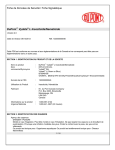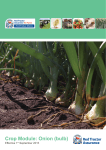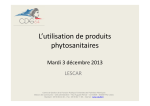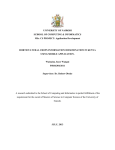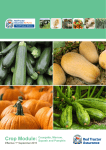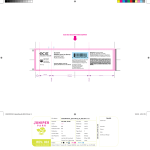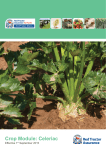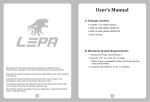Download USER GUIDE NOTES
Transcript
Integrated control of potato cyst nematode (PCN) Globodera pallida, the white potato cyst nematode USER GUIDE NOTES Getting Started We have started by selecting the named-cultivar mode and then a single cultivar strategy by clicking on “single”. For these examples we have selected a Sandy Loam soil from the drop down menu and entered a starting population of 10 eggs/g of soil. In this first example we have chosen Estima with a target yield of 45/t and a rotation of 6 years. We have opted for no nematicide treatment. We can now move freely between predictions, population trends and yield trends using the tabs below the diagrams. The model predicts an increase in nematode population caused by the cropping, and a reduced yield through nematode feeding (27.8t). When we switch to yield trends and population trends we can see how this strategy would lead to a steady increase in PCN (through insufficient periods of decline) and permanently depressed future yields. To make this cropping pattern more sustainable we could shift the rotation to 12 years. OR . . . Stick with 6 year rotation but use a granular nematicide. OR . . . Stick with 6 year rotation and use a combination of fumigation and granular application. OR . . . others! Example of 10 year rotation with granular nematicide. In this second example we have again used a Sandy Loam with 10 eggs per gram but this time planted Cara which differs in its resistance and tolerance to PCN This time we achieve a (relatively) respectable yield but have created a very high final PCN population. For subsequent crops in a 6 year rotation we can see how yields are depressed and population stabilises at ~100 eggs/g. In the absence of nematicide we would need a 20 year break between crops to achieve a sustainable PCN population and respectable yield. In the third scenario we have selected a multiple cropping strategy. This allows us to look at what would happen if we use different variety, in the same field, over a period of time. Data is entered in much the same way but this time it is assigned to Crop1, Crop2, Crop3 etc so that we can consider individual crops, rotation lengths and treatments. The trend data is expressed in much the same way as before, but now we can see the consequences of following a Cara crop with Estima. Additional Features This model has been created using the best estimates available of PCN decline rate and nematicide activity. You may find over time that things change; our PCN population could become more or less virulent or, nematicides are developed or reformulated to become more effective. The model has been future-proofed to deal with this and by clicking on Edit, Setup and settings, you will be able to adjust PCN decline rates and nematicide efficacy. If you have real Pf:Pi data for a particular field, using this function to adjust the model will make the predictions more realistic for that site. In the examples below we have firstly adjusted the decline rate to account for a volunteer problem and then adjusted the efficacy of a granular nematicide to account for poor or inappropriate application Change to account for e.g. poor tilth, poor callibration Change to account for e.g. volunteer problem You can also add to or adjust the variety data where you have details of tolerance and resistance using the Modify Cultivar List option. British Potato Council 2005 Please Note This guide is based on the best available information and the British Potato Council has provided it in good faith. The BPC will not be liable for any omissions or inaccuracies therein, nor for any costs, loss or damage resulting from interpretation of, or decisions based on, the information provided.










